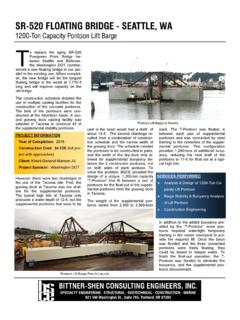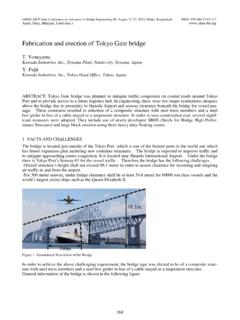Transcription of Hermle€Floating€Balance Summary€of€Inspection,€Diagnosis ...
1 Hermle floating BalanceSummary of Inspection, Diagnosis, Cleaning and Repair ..prepared by David RobertsonDescription:xThe assembly consists of a balance wheel, 2 jeweled bearings on each end of a hollow tube ridingon a pivot wire supported in a U-shaped most common reasons for a sluggish balance are dirt, rust/pitting/roughness of the wire, bentwire or excess oil on the wire & of floating balance from clock:xRemove both screws and tilt balance assembly so as to avoid bending pallet and testing of balance:xVisual inspection (with balance assembly held upright):xCheck for bent for corroded/pitted/rough for equal gaps between top and bottom tube ends and top and bottom jewels for wheel should bounce freely up and down on and bottom of frame should be parallel to each other and perpendicular to the back of balance should be in beat the roller pins should be in the exact center, viewed from balance in and lower sections of hairspring should spiral in and out should not move sideways or up and should not move up and down on safety roller.
2 It should rotate on center and be true in round and in balance in bench balance wheel 270 deg and balance wheel should oscillate 3-5 it passes test, do not it fails test, clean balance balance:xUse several small watch cleaner or non-aqueous clock in cleaner by hand or briefly in one or more containers of clean solution to assembly using heat and piece of absorbent paper at lower jewel hole to remove cleaner/rinsefrom Balance:xMost repair persons recommend no most, apply a miniscule drop of watch oil where the wire passes through each jewel off excess after balance problems after inspection & testing:xBent wire straighten by bending opposite direction using pressure on or broken wire replace wire as follows or replace balance upper and lower tabs sufficiently away from frame to allow removal of wire.
3 Diagonalpliers or flush-end cutters are good for this old proper size of wire (usually .25mm). Use spring steel wire in largest size availablethat does not exceed diameter of old 6 in piece. If unable to get straight section, place 10 in piece in vise and pull apaart withpliers. This will leave a shorter piece of very straight wire through top frame and through tube. Make 90 deg bend in wire at bottom of wire to lower tab with 2-3 wraps and press tab back into bracketxSqueeze upper and lower frame arms together slightly and fasten wire to upper tab. Don tpermanently deform pressure to allow wire to become more upper tab back into off excess not centered between upper and lower part of frame correct as follows:xMove lower collet on tube to align, orxIf misalignment is caused by bent hairspring, correct hairspring roller not aligned - Adjust by slight twisting of roller action - if not corrected by cleaning or straightening wire, replace wire or jewels replace balance action of hairspring manipulate/form hairspring to correct frame bend to proper of beat rotate top (or bottom) collet so that roller pins are exactly in center of balanceassembly when viewed from inspection and repair.
4 XCheck and adjust fork as follows (these will establish initial, ideal conditions but may need finetuning after full assembly):xFork neck parallel to platesxFork slot parallel to pallet arborxSafety guard parallel to fork neckxInside corners of fork slot at 90 deg anglexEnd caps smooth and not binding pallet arborxSlight end shake on pallet arborxCheck and adjust pins on anchor so that they are parallel to pallet arbor and perpendicular toanchor. If adjustment is needed, try to bend brass rather than pins themselves to prevent of balance assembly:xReinstall in clock, holding assembly at an angle as you lower it between the screws just enough to remove slack. Do not tighten and adjustment after installation:xPenetration of roller pins into fork slot should be to pin diameters adjust by bending forkneck forward or for slight clearance (side shake) between roller pins and sides of fork slot.
5 Open slot clock a few turns to put some power on for adequate and equal slide on both sides as follows:xOperate balance wheel manually. Observe the exact instant of drop-lock on escape drop-lock the gap between the fork neck and the guard pin should be 1-2 pin diameters andequal on each adjust equality of drops, loosen balance assembly where it mounts to clock plate and twistappropriate direction to move guard pins and equalize distances to fork neck. Balanceassembly may have to be twisted (mild deformation) to achieve desired , fork can be bent appropriate roller pins do not clear corners of fork slot, twist fork slightly to provide guard pin binds on saftey roller,xAdjust safety roller to be concentric to tube, orxBend guard pin to avoid Balance:xWind clock should develop 1-1 turns of rotation after 2-3 should maintain -1 turn of rotation after running 7 and regulating:xUse clutch assembly on top of balance wheel for minor adjustments (3 min per day).
6 XAdd or remove weights (in 180 degree opposite pairs) for greater adjustments (see diagram).xAdd weights= slowerxRemove weights=fasterThe preceding summary was prepared as a memory jogger for the repairperson who already has aworking knowledge of floating balance testing, adjustment and repair for this summary is taken from the following articles reinforced by personal observation:1. The floating Balance by Joseph Cerullo, CMW published in Clockmakers NewsletterSeptember 1987 December A Practical Guide to the floating Balance Escapement by Timothy R. White, published in theNAWCC Bulletin, Whole Number 224, June following four diagrams are relevant to the preceding discussion.
7 They are extracted from thecited Frame, 1a. Upper frame bridge , 1b. Lower frame bridge , 2. Pivot wire, 3. Hairspring stud, 4. Jewelledbearing, 5. Hollow tube, 6. Hairspring, 7. Mounting post, 8. Regulator with disc, 9. Banking pins, 10. Rollerpins, 11. Safety roller, 12. Balance Wheel, 13. Hairspring collet, 14. Upper frame hook, 15. Lower frame hook,16. Pallet fork, 17. Safety Guard, 18. Pallet pins, 19. Escape wheel. x slide, y lateral swing of pallet .(three drawings above used with permission from Clockmakers Newsletter)5 The following drawing illustrates the effect of adding or removing 180 deg opposite pairs of weights







